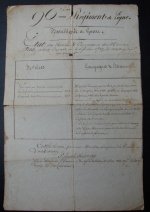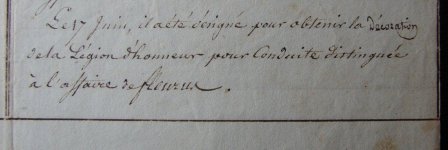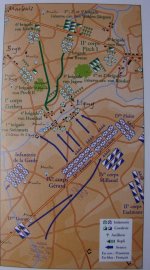Two weeks ago I added this little document to my collection, this time it isn’t a Soldbuch but an “Etat de service” from 1829.
OK it isn’t a WW2 German document so it is a bit off topic but I’ am sure you guys will not mind.
This type of document was written after a French soldier left the army it is basically a curriculum vitae.
Albert Petit born on February 6 1789 (the year of the French revolution) in Martiny was a conscript in Napoleon’s army, he started his service in February 1808 with the 96[SUP]th[/SUP] Line Infantry Regiment, he fought with them in Austriain 1809, in the Peninsula campaign from 1810 till 1813 and finally in the south of France in 1814.
During these years he was wounded three times: on June 1 1812 in Spain during the battle of Burnos he got shot in the right hand, in the defense of Arcola(Spain) he was shot again this time in his right arm and once again he was wounded in the battle for Toulouse (France) on April 10 1814 a wound to his right shoulder.
So far his service is pretty basic for a conscript infantry soldier in the Napoleonic wars.
Notice that he wasn’t promoted once in his first period (until Napoleon’s abdication) of 16 years of service; this was normal in the French army of this period soldiers could only be promoted if they could read and write, so I presume that he was illiterate.
It is in 1815 after Napoleon returns from Elba that his career becomes very interesting; in June 1815 his regiment is part of the “Armee du Nord” that will invade Belgium, the 96[SUP]th[/SUP] Line Regiment is 1438 men strong and is commandedby colonel Goujeon, together with the 30[SUP]th[/SUP] Line Regiment they are the first brigade of the 12[SUP]th[/SUP] Infantry Division which is commanded by lieutenant general Pecheux, this division belongs to the IV’th Army Corps under the command of lt-gen Gérard.
The invasion of Belgium, which we now know as the Waterloo campaign, starts on June15 1815, Napoleon’s plan is to divide the allied armies first beating the Prussians under the command of von Blucher and then dealing with the army under command of the duke of Wellington, on the first day Charleroi is taken and the French army marches north, the next day the complete Prussian army is waiting for them just North of Fleurus in the hamlets in and around the village of Ligny, the Prussian army covers the strategic important road between Quatre-Bras and Namur.
The battle that will be fought on June 16 1815 is now known as the battle for Ligny, the prelude of the battle of Waterloo, also knick named Napoleon’s last victory.
This little known battle wasn’t a small skirmish; it was a full size battle in which many men lost their lives, it was a fierce battle in which no prisoners were taken.
There are no exact figures on the losses but it is estimated that the French lost 10 to 12.000 men (killed and wounded) and the Prussians 16 to 20.000 men.
The battle for Ligny got lost in history because it was the Duke of Wellington that wrote the history of the Waterloo campaign and he focused mainly on his victory of June 18 1815, in his report the Prussians only got limited attention and thus the battle of Ligny was soon forgotten.
The IV’th Army Corps of lt-gen Gérard forms the centre of Napoleon’s army; this corps will be engaged in the second stage of the battle.
The battle of Ligny is a battle of attack followed by counter attack, hamlets that change hands several times; it is a slaughter in which the French army finally comes out on top.
For Albert Petit the battle of Ligny starts at 16.00, at this time his unit gets the order to drive the Prussians out of Ligny village, his regiment is part of the left wing of lt-gen Gérard’s corps and it will approach the village through the Rue en Haut.
The battle for control of the centre of Ligny is fierce!
It will change hands four times before the battle ends at 22.00.
Bayonet charges, close combat in the narrow streets of this little town.
Albert Petit conducted himself so well that a few hours after the battle he gets a battlefield promotion to corporal and is awarded with the “Legion D’Honneur”, the highest French award for bravery.
Because the Legion D’Honneur was awarded so soon after the battle, I presume it wasNapoleon himself that decorated this brave soldier.
In the past I have visited the battlefield several times and I have included some pictures I made during one of my hikes in Ligny in this thread.
OK it isn’t a WW2 German document so it is a bit off topic but I’ am sure you guys will not mind.
This type of document was written after a French soldier left the army it is basically a curriculum vitae.
Albert Petit born on February 6 1789 (the year of the French revolution) in Martiny was a conscript in Napoleon’s army, he started his service in February 1808 with the 96[SUP]th[/SUP] Line Infantry Regiment, he fought with them in Austriain 1809, in the Peninsula campaign from 1810 till 1813 and finally in the south of France in 1814.
During these years he was wounded three times: on June 1 1812 in Spain during the battle of Burnos he got shot in the right hand, in the defense of Arcola(Spain) he was shot again this time in his right arm and once again he was wounded in the battle for Toulouse (France) on April 10 1814 a wound to his right shoulder.
So far his service is pretty basic for a conscript infantry soldier in the Napoleonic wars.
Notice that he wasn’t promoted once in his first period (until Napoleon’s abdication) of 16 years of service; this was normal in the French army of this period soldiers could only be promoted if they could read and write, so I presume that he was illiterate.
It is in 1815 after Napoleon returns from Elba that his career becomes very interesting; in June 1815 his regiment is part of the “Armee du Nord” that will invade Belgium, the 96[SUP]th[/SUP] Line Regiment is 1438 men strong and is commandedby colonel Goujeon, together with the 30[SUP]th[/SUP] Line Regiment they are the first brigade of the 12[SUP]th[/SUP] Infantry Division which is commanded by lieutenant general Pecheux, this division belongs to the IV’th Army Corps under the command of lt-gen Gérard.
The invasion of Belgium, which we now know as the Waterloo campaign, starts on June15 1815, Napoleon’s plan is to divide the allied armies first beating the Prussians under the command of von Blucher and then dealing with the army under command of the duke of Wellington, on the first day Charleroi is taken and the French army marches north, the next day the complete Prussian army is waiting for them just North of Fleurus in the hamlets in and around the village of Ligny, the Prussian army covers the strategic important road between Quatre-Bras and Namur.
The battle that will be fought on June 16 1815 is now known as the battle for Ligny, the prelude of the battle of Waterloo, also knick named Napoleon’s last victory.
This little known battle wasn’t a small skirmish; it was a full size battle in which many men lost their lives, it was a fierce battle in which no prisoners were taken.
There are no exact figures on the losses but it is estimated that the French lost 10 to 12.000 men (killed and wounded) and the Prussians 16 to 20.000 men.
The battle for Ligny got lost in history because it was the Duke of Wellington that wrote the history of the Waterloo campaign and he focused mainly on his victory of June 18 1815, in his report the Prussians only got limited attention and thus the battle of Ligny was soon forgotten.
The IV’th Army Corps of lt-gen Gérard forms the centre of Napoleon’s army; this corps will be engaged in the second stage of the battle.
The battle of Ligny is a battle of attack followed by counter attack, hamlets that change hands several times; it is a slaughter in which the French army finally comes out on top.
For Albert Petit the battle of Ligny starts at 16.00, at this time his unit gets the order to drive the Prussians out of Ligny village, his regiment is part of the left wing of lt-gen Gérard’s corps and it will approach the village through the Rue en Haut.
The battle for control of the centre of Ligny is fierce!
It will change hands four times before the battle ends at 22.00.
Bayonet charges, close combat in the narrow streets of this little town.
Albert Petit conducted himself so well that a few hours after the battle he gets a battlefield promotion to corporal and is awarded with the “Legion D’Honneur”, the highest French award for bravery.
Because the Legion D’Honneur was awarded so soon after the battle, I presume it wasNapoleon himself that decorated this brave soldier.
In the past I have visited the battlefield several times and I have included some pictures I made during one of my hikes in Ligny in this thread.

















